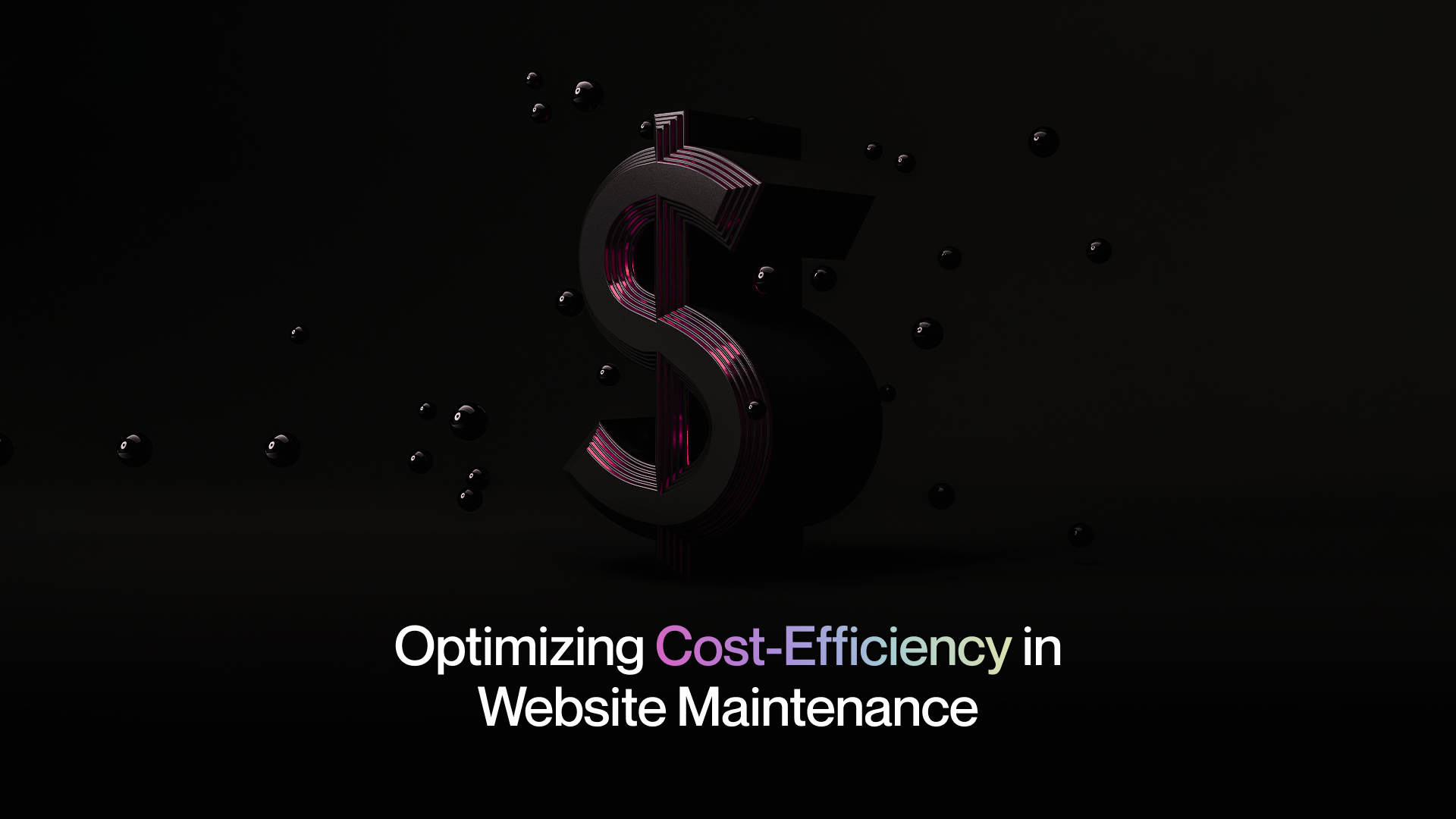Your website is the face and representation of your business, but simply creating your website is the first initial step.
To fully leverage the potential of your website, consistent website management and care are crucial.
Your website is an ever-evolving component of your business. It's much more than a one-time, set-and-forget digital pamphlet.
It demands ongoing nurturing and attention.
This involves regularly enriching the user experience with updated content and ensuring mobile compatibility, as well as protecting your site against security risks, as well as boosting your search engine visibility through SEO practices and tactics.
Each facet of upkeep plays a significant role in enhancing your website's overall functionality and success.
This article explores the importance of website maintenance for long-term success.
Improving the User Experience
Elevating the user experience is an essential component of website upkeep. A superior user experience not only captivates visitors but also motivates them to revisit your site.
Here are five critical areas underlining the significance of user experience enhancement:
Continual Content Refreshment
A key strategy in boosting user experience is to regularly supply fresh content. Keeping your website updated with new articles, blogs, or product updates maintains visitor engagement and provides them with the latest information. Users are more inclined to spend no more time and delve deeper into your site when they encounter valuable, current content. A robust content strategy can significantly enhance your industry standing. Providing consistent, high-quality content establishes your website as a credible source of information, attracting more visitors and solidifying your competitive position.
Adaptability of Mobile Devices
A mobile-adaptive or mobile-friendly website is vital. This means your site adjusts its layout and features to suit various screen sizes, offering a fluid experience on smartphones and tablets. A mobile-optimized design ensures easy access and navigation for users, regardless of their device.
Swift Page Load Times
Your website's loading speed profoundly affects the user experience. Slow-loading pages can deter visitors, leading to higher abandonment rates. Part of website maintenance is enhancing site performance to ensure quick and efficient page loads. Quicker load times not only improve user experience but also boost search engine rankings, as search engines favor fast-loading sites.
Intuitive Site Navigation
Clear and easy navigation is crucial for directing visitors around your site. A logically structured menu, straightforward calls to action, and readily accessible information help users effortlessly find what they need. Regular website maintenance includes optimizing navigation to ensure a coherent and user-friendly journey.
Ensuring Accessibility
Web accessibility ensures that your site is usable by individuals with disabilities. A website that meets accessibility standards allows all users, including those with disabilities, to engage with your content effectively. This not only enhances the user experience but also showcases your dedication to inclusivity and equal access.
Strengthening Security

Protecting your website and the sensitive data it processes is a crucial component of website maintenance. Let's look into the specific components needed for proper maintenance:
Frequent Software Updates
Consistently updating your website's software serves as a fundamental safeguard against security threats. Content management systems (CMS) like WordPress, along with various plugins, often release updates incorporating security enhancements. Neglecting these updates can leave your website vulnerable to attacks exploiting these weaknesses.
Application of Security Patches
Beyond regular software updates, specific security patches are vital for addressing known vulnerabilities. As hackers continually probe for website weaknesses, these patches are critical in sealing these security gaps. Diligent application of these patches is a key part of maintaining your website's defenses.
Implementation of SSL Certificates
Secure Sockets Layer (SSL) certificates are essential for encrypting data exchange between your website and its users. This encryption protects sensitive information, such as login credentials and financial details. Regular checks and proper configuration of your SSL certificate are imperative for robust website security.
Firewall Deployment
Using a web application firewall (WAF) is an effective strategy against cyber threats. A WAF serves as a protective barrier, filtering harmful traffic and thwarting unauthorized intrusions. Configuring and upkeeping your firewall is a vital element of securing your website.
Enhanced User Authentication
Robust user authentication processes are crucial for websites with user accounts. Implementing strong password requirements, multi-factor authentication (MFA), and monitoring login attempts are essential practices to safeguard against unauthorized access to user accounts.
Enhancing Website Performance

The performance of your website is critical to maintaining competitiveness and user-friendliness. A slow website can deter visitors and negatively impact your search engine rankings.
Website maintenance encompasses a range of tactics and practices aimed at performance optimization. Here a the maintenance solutions needed to keep your site performance in top form:
Diligent Server Monitoring
Server monitoring is a vital part of website upkeep. It involves continuous supervision of your site's server infrastructure to promptly identify and address potential issues. This ensures uninterrupted access for users. Server monitoring tools offer real-time insights into server health, tracking metrics like CPU usage, memory usage, and bandwidth. These insights enable administrators to pinpoint and address performance bottlenecks quickly.
Streamlining Performance
Optimizing website performance involves refining various elements to enhance loading speeds and responsiveness. Techniques such as image compression, code minification, and leveraging browser caching are key. These methods help reduce file sizes, cut down load times, and improve overall user interaction.
Analyzing Web Traffic
Traffic analysis is the study of user interactions and behaviors on your site. By assessing this data, you gain insights into visitor navigation patterns, page visits, and engagement duration.
This information guides strategic decisions to further refine website performance. For instance, if a page exhibits high bounce rates, this data can inform targeted improvements.
Utilizing Content Delivery Networks (CDNs)
Content Delivery Networks (CDNs) are a system of servers that distribute and deliver web content based on user location. A CDN can enhance website performance by reducing server burden and cutting down latency. CDNs distribute static resources like images and scripts across global servers. This means when a user visits your site, the CDN delivers content from the nearest server, thereby accelerating load times and enhancing user experience.
Prioritizing Mobile Optimization
Given the rise in mobile internet usage, making your website mobile-friendly is crucial for optimal performance. Mobile optimization ensures that your site adjusts effectively to smaller screens. Key aspects of mobile optimization include responsive design, mobile-adapted menus, and touch-friendly interfaces. This focus on mobile users expands your reach and ensures a consistent experience across all devices.
Mitigating Website Downtime

Website downtime, when your site is not accessible to users, can significantly hinder your online presence. To ensure constant accessibility and functionality of your website, it's vital to implement strategies aimed at minimizing downtime.
Here are five key aspects to consider:
Consistent Website Backups
Frequent backups of your website data and content are fundamental in guarding against incidents leading to downtime. These backups act as a fallback, enabling you to reinstate your site in the event of data loss, hardware malfunctions, or security compromises.
Incorporating regular backups into your maintenance routine is crucial. Automated backup systems can capture even the latest site changes. It's also important to store these backups in multiple, secure locations to protect against various risks, such as server failures or natural calamities.
Utilizing Monitoring Solutions
Active monitoring of your website’s performance and health is key in preempting downtime. Monitoring solutions can identify issues before they worsen, allowing for swift corrective actions. These tools offer insights into server reliability, response times, and traffic trends. Alerts can be set up to notify you when unusual patterns or critical thresholds are reached. Early detection of problems enables timely intervention, preventing user impact.
Technical Support
Having frequent technical support is invaluable for immediate downtime prevention and resolution. Technical issues can arise unexpectedly, necessitating immediate attention. Continuous support ensures that expert help is always available. Technical web development teams can rapidly address issues related to server upkeep, software updates, or security breaches. This immediate response is crucial in curtailing downtime duration and effects.
Implementing Redundancy and Failover Mechanisms
Adopting redundancy and failover systems is effective in bolstering site uptime. Redundancy means duplicating vital infrastructure components to guarantee operational continuity in case of a component failure. Failover systems automatically switch to a backup when a failure is detected, minimizing service interruptions and maintaining operational continuity. These systems are particularly crucial for high-traffic or mission-critical websites.
Developing a Recovery Plan
A comprehensive recovery plan is essential for addressing unforeseen events that might cause prolonged downtime. This plan should detail response procedures for various disaster scenarios, including server breakdowns, security breaches, or natural disasters.
A robust disaster recovery plan outlines data recovery steps, hardware replacement, stakeholder communication, and responsibility allocation. Regularly testing and updating this plan ensures its efficacy in reducing downtime and its associated impacts.
Ready to unlock the full potential of your Webflow website? Imbassy’s Webflow Maintenance Services are here to ensure everything runs perfectly!
Enhancing Competitive Advantage

In the dynamic digital world, maintaining a competitive edge in your industry is essential, and your website is a key player in this arena. Here is how website maintenance can give you a competitive edge:
Embracing Current Trends
Staying competitive necessitates keeping your website in sync with the latest industry trends and standards. The landscape of web design, user experience, and technology is constantly evolving. Regular updates to your website's design and functionalities to align with these trends showcase your dedication to providing a contemporary and relevant user experience.
Insightful Competitor Analysis
Evaluating the websites of your competitors can yield valuable insights. Understanding both their strengths and weaknesses enables you to make strategic decisions to set your website apart. This analysis helps in pinpointing areas for enhancement and innovation, allowing you to surpass your competitors in the digital domain.
Valuing User Feedback
Paying attention to user feedback is crucial in website maintenance. Actively seeking and assessing user input can highlight ways to improve your website to better satisfy user needs and preferences. Addressing user feedback shows your commitment to offering an outstanding online experience, distinguishing you from competitors who may not be as attentive to their audience.
Continuous A/B Testing and Optimization
Staying competitive means constantly evolving. Employing A/B testing and optimization techniques enables you to experiment with various website aspects, such as design layouts, call-to-action buttons, and content presentation. Adjusting your website based on these empirical insights helps optimize user engagement and conversion rates, giving you an advantage over competitors with less adaptive websites.
Strategic Content Development
Content is a vital component in attracting and retaining your audience. A robust content strategy that includes regular updates, engaging blog posts, informative articles, and captivating multimedia can significantly enhance your industry standing. Providing consistent, high-quality content establishes your website as a credible source of information, attracting more visitors and solidifying your competitive position.
Optimizing Cost-Efficiency in Website Maintenance

In the competitive realm of online business, executing cost-effective website maintenance is crucial. It involves making smart decisions to keep your site efficient, secure, and updated without excessive expenses. Below are five key aspects that emphasize the significance of maintaining your website cost-effectively:
Proactive Approach Over Reactive Measures
Cost-efficiency in maintenance hinges on being proactive rather than reactive. Reactive maintenance, which addresses issues only when they become urgent, often incurs higher costs and risks downtime. Conversely, a proactive strategy involves consistent monitoring, updating, and preventive actions to tackle potential problems early. This approach not only prevents expensive emergency repairs but also saves money over time.
Strategic Budget Management
Effective maintenance starts with thoughtful budgeting. Appropriately allocating funds for various maintenance tasks, such as software updates, security protocols, and content management, is crucial. This organized budgeting prevents overspending and enables prioritizing tasks based on their necessity and impact on your site's functionality.
Preventing Costly Overhauls
Ignoring routine maintenance can lead to severe problems, necessitating expensive repairs or complete website revamps. Cost-effective maintenance means promptly addressing small issues to prevent them from escalating into larger, more costly ones. This preventive approach significantly lowers the financial strain of website upkeep.
Utilizing Automation and Tools
Employing automation and maintenance tools can make the maintenance process more efficient and less expensive. Tools for automated backups, security checks, and content management not only save time but also reduce labor costs, making the process more streamlined and cost-effective. Investing in these tools can be advantageous, minimizing manual effort and reducing errors.
Focus on Training and Skills Enhancement
Investing in the training and skill development of your maintenance team or yourself can result in long-term savings. A skilled team can more effectively manage maintenance tasks, reducing the need for external consultants for regular maintenance. Keeping abreast of the latest technologies and best practices enhances operational efficiency and lowers the likelihood of expensive errors.
Prioritizing Data Protection and Privacy

The protection of user data on your website is critical. Here are five key areas highlighting the significance of data protection and privacy in website maintenance:
Responsible User Data Management
Handling user data responsibly is a cornerstone of data protection and privacy. Websites typically collect a variety of user information, including personal details, email addresses, and browsing habits. It's vital to establish stringent protocols for the collection, storage, and use of this data. Adopting transparent practices in data management not only ensures compliance with legal standards but also builds trust with your website visitors.
Transparent Privacy Policies
Having a clear, easily accessible privacy policy is a must for any website. This policy should detail your data collection, storage, and use practices, offering transparency to your visitors. It informs users about their rights to their data. Continuously updating your privacy policy to reflect current data protection legislation and best practices is an important part of website maintenance.
Ensuring Data Encryption
Encrypting data exchanged between your website and its users is crucial for safeguarding against unauthorized interception. Using secure sockets layer (SSL) encryption helps keep sensitive information like login credentials and financial details confidential. Regular monitoring and renewal of SSL certificates are necessary to uphold data encryption standards.
Secure Online Transaction Processing
For websites that handle online transactions, ensuring secure payment processing is imperative. This includes integrating reliable payment gateways and adhering to security protocols like the Payment Card Industry Data Security Standard (PCI DSS). Continuously ensuring that your payment processes are secure and protected against breaches is a key responsibility in website maintenance.
Ensuring Long-Term Viability of Websites

In the dynamic digital world, securing the long-term viability of a website is crucial. A site that can adeptly adapt to shifts in technology, user preferences, and market trends is more likely to succeed over time. Here are five essential factors to consider for your website's sustained success:
Emphasis on Scalability
Scalability is your website's ability to accommodate growing demands, such as increased traffic, expanding content, and enhanced features. Non-scalable websites may struggle with performance issues or downtime as they gain popularity. To achieve scalability, selecting a capable hosting solution, utilizing efficient coding, and regularly evaluating your site's capacity are key.
Strategy for Future-Proofing
Future-proofing your website means preparing for upcoming technological shifts and evolving user behaviors. This involves staying informed about new web development technologies, ensuring compatibility with emerging devices and browsers, and planning for the integration of future trends and functionalities.
Commitment to Technology Upgrades
Given the fast pace of technological advancement, keeping your website's technology updated is essential. Regularly upgrading the content management system (CMS), programming languages, and frameworks is crucial to maintain competitiveness and security. Neglecting updates can lead to compatibility issues and heightened security risks.
Developing a Robust Content Strategy
A sustainable website is supported by a strong content strategy. This means strategically planning, creating, and managing content that supports your long-term objectives. It involves adapting to the evolving needs and preferences of your audience to ensure your content stays relevant and engaging.
Adopting a User-Centric Design
The enduring success of a website ultimately depends on its ability to satisfy user needs. A user-centric approach entails ongoing user research, gathering feedback, and optimizing the user experience. By focusing on user satisfaction and usability, your website can continually evolve to align with user expectations, thereby enhancing its longevity.
Final Thoughts
The importance of regular website maintenance goes beyond being a mere static entity, your website is a dynamic, vital aspect of your brand or online identity, directly influencing your success.
Effective website maintenance transcends technical responsibility; it's a strategic investment for the longevity of your online presence.
By keeping pace with technological advancements and prioritizing user satisfaction, your website remains a significant asset in achieving your business goals.
Author
.jpg)

.jpg)
